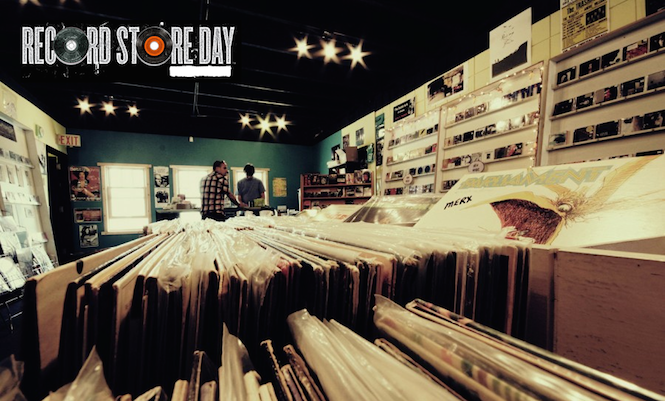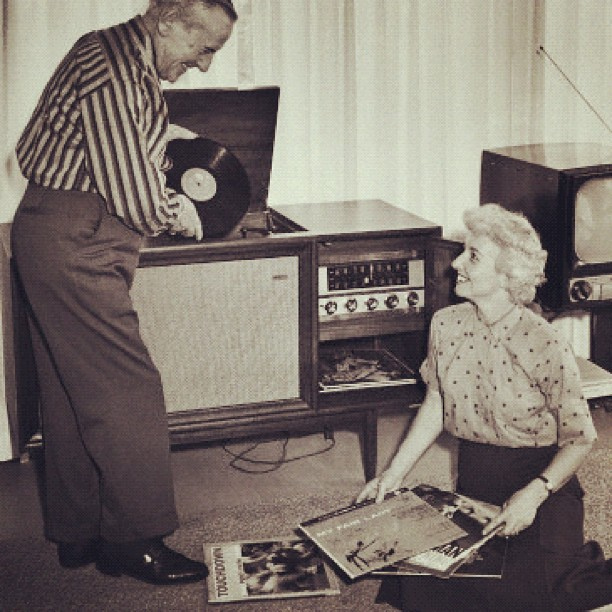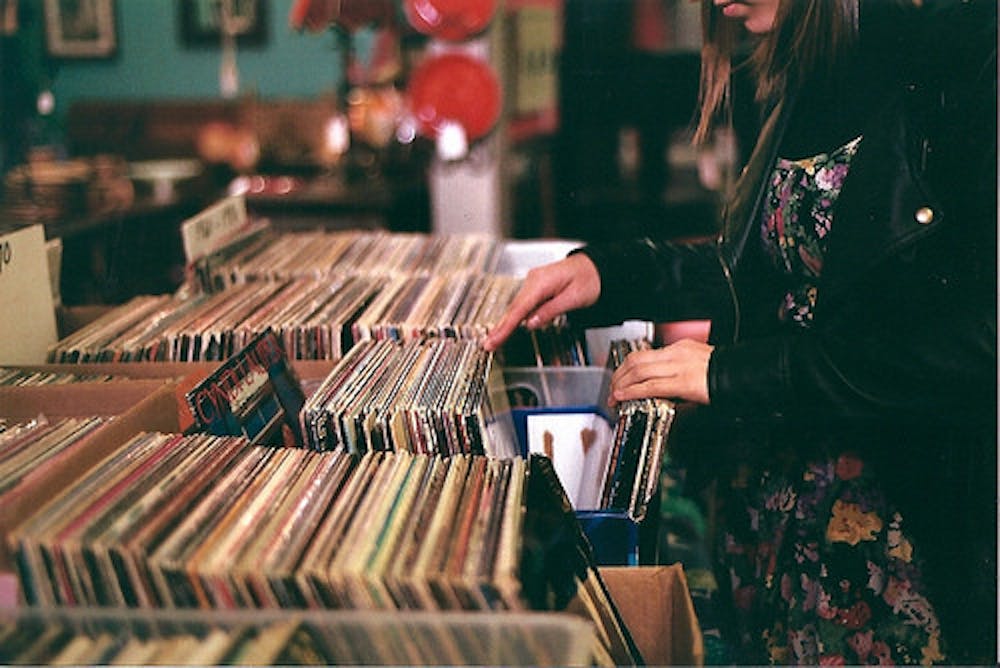So I recently wrote this essay for one of my classes about how the vinyl revival is actually hurting smaller artists and labels. The prompt was to address a up and coming or ongoing problem in the music industry and try to find a solution. I was pretty content with the turnout of the paper and I thought "hey this could be a good blog post," so here you go.

In recent years, streaming has taken hold of the music industry. Users can stream music through Google Play, Spotify, Youtube/VEVO, etc. The streams are measured by the number of plays a track or album receives. Essentially, the listener does not own physical or digital copies of the tracks and can only listen to them on whichever streaming platform they prefer.
Nielsen, the music industry’s leading data provider, states that streaming has grown considerably with over 164 billions streams between 2013 and 2014; roughly a 54.5% increase in streams. Katy Perry’s “Dark Horse” topped the charts with 268,322,000 streams followed by Iggy Azalea’s “Fancy.” Although the streaming industry seems to be thriving, total album sales have shown a decrease of about 11.2%. CDs had a decrease of 14.9% and digital albums are not far behind with a decrease of 9.4%. Despite the fact that the overall sale of albums showed a steady decrease, there was a peculiar growth of 51.8% in Vinyl/LP sales, almost as much as streaming. Much debate has gone into why there's suddenly such high demand for vinyl and many have agreed that it is all part of cultivating a certain image.
A Billboard article published in 2015 attempted to explain what is happening with the industry and claimed that there is a certain perception about “collect[ing] something physical and tangible at a time when most culture lives as data in the cloud or on a hard drive.” The article also explains that the whole “vinyl revival” is about image, quoting Rik Sanchez of Amoeba GM, “having a record in your hand is just way cooler than having a file in your iPod.” According to the NPD, music fans under the age of 35 now account for over 72% of vinyl sales, and many retail stores have even attempted to make money off of the revival by stocking their selves with reprints of classic rock operas and the newest hits, explaining why you may have seen records alongside clothes at stores like Urban Outfitters and Hot Topic.
An article published by Quartz agreed with the Billboard article, claiming that the vinyl revival is about “identity.” Discrediting the ideas of vinyls serving as nostalgia and being better quality, the article makes a sound argument that the growth is purely stressed around image. Nielsen reported that Jack White’s Lazaretto topped the vinyl charts with 86,700 sales and was followed by more contemporary music and reprints of some classics like the Beatles’ Abbey Road and Bob Marley & the Wailer’s Legend. While the reinvigorated vinyl industry may seem as a blessing for fans, stores and artists alike, it proves to be a disaster for others. Many smaller artists and labels are going bankrupt because they are not able to keep up with the growing market. The vinyl revival has proven to favor bigger names and labels, rather than smaller ones; doing the exact opposite of its intentions.

Record Store Day and Corporate Monsters: another nail in the coffin
Nirvana’s former drummer and the Foo Fighter’s frontman, Dave Grohl, was appointed the ambassador of Record Store Day 2015. His duties involved publically stressing the importance of independent record stores and vinyl, according to Rolling Stone. On the official Record Store Day website, Dave Grohl made an statement about how he “found my [his] calling in the back bin of a dark, dusty record store.” Record Store Day was founded eight years ago and was created to help save the independent record stores, but in recent years it has turned into “just another event in the annual music industry circus,” according to a Pitchfork article criticizing what Record Store Day has become. The official Record Store Day website states that:
“A Record Store Day participating store is defined as a stand alone brick and mortar retailer whose main primary business focuses on a physical store location, whose product line consists of at least 50% music retail, whose company is not publicly traded and whose ownership is at least 70% located in the state of operation. (In other words, we’re dealing with real, live, physical, indie record stores—not online retailers or corporate behemoths).”
Contradictorily, Warner, Universal, and Sony all participate quite successfully in Record Store Day. Although, many may feel as if because of the recent boom in vinyl sales there is enough wealth to go around, they are sadly mistaken.
According to an article on Noisey, the biggest problem for smaller artists, labels, and stores is backorder. There are only 20 vinyl-pressing plants nationwide pressing everything from all 86k of Lazaretto to smaller indie-punk bands who are “relying on selling ten or 20 LPs per show to put gas in their rental van to get to the next city.” As per assumption, the bigger artists orders are carried out first and smaller artists are snubbed out because of the high demands. Many indie-bands find themselves going on tour with half of their requested vinyl merchandise because of Lana Del Rey’s 42k copies of Born to Die. Others find themselves going on tour without any vinyl or completely cancelling their tour. Not only are the smaller artists being hurt, but so are smaller labels and record stores.
Record Store Day features “exclusive” album releases that are only available for that day or are released on that day, creating a demand that justifies the inflated prices. Indie record stores must put in their orders with the 20 pressing plants months in advance just so that they can attempt to make a little profit off of the holiday that was once supposed to help them. Yet, corporations still get their orders completed on time. If the industry keeps hurting its smaller players, pretty soon there will be no more independent anything; not only will the artists, labels, and stores be hurt, but also the fans. The younger generations will never know the feeling that Dave Grohl talks about of walking downtown into a dusty, old brick building where a half-lit neon sign welcomes you and finding a vintage “Tommy” by the Who. They will never get to experience seeing a local band with a name involving some type of food or dinosaur playing in some guy’s basement and buying their vinyl off a merchandise stand in the back of the room.

Saving the Little Guys
One solution to the problem would be to create more pressing plants. More plants would mean more jobs, more opportunities, and most importantly more vinyl. The smaller artists would be able to get in their orders and so would bigger bands with higher demand.
Another solution would be to have communities become the backbone of local artists, labels, and stores. If neighbors and friends took it upon themselves to support the “little guys” and boycott the corporations that are keeping them down, the industry could be saved. The author of the Pitchfork article, Eric Harvey, talks about how there are a few smaller locations out there that are participating in holidays such as Record Store Day and doing so successfully with the help from their community. He references Bloomington's Landlocked Music as being one the last to still be genuine and have a love and passion for the “unique culture.”
Fixing the industry is not as simple as it seems or else it would have already been done. The vinyl revival is surfaced around image, according to many critics, and that is a huge problem for the industry. Right now, Vinyl is seen as “cool” and that does not look like it is going to change anytime soon according to market trends. Corporations have their hands in the industry and the 20 pressing plants, and are making it nearly impossible for smaller artists, labels, and stores to become successful. Not only are they being disregarded, but also the one holiday put in place to help them is doing the exact opposite. Hopefully in the near future, the market will see a growth in the sales for smaller artists, labels, and stores.






